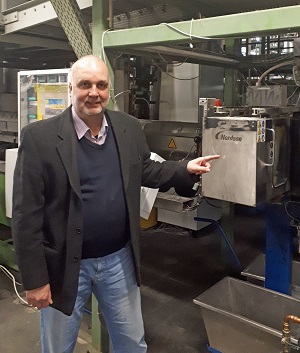An advanced melt filtration system from Nordson Corporation has enabled Cyklop, an international supplier of industrial packaging systems for load securement, to increase productivity, reduce downtime, and cut material waste in the production of strapping tape from PET bottle flake.
At its facility in Cologne, Cyklop GmbH replaced an older-model hydraulically powered backflush screen changer with the recently introduced BKG® HiCon™ V-Type 3G system. Cyklop reports that the new screen changer reduces operating costs because it needs 30% fewer backflushes and requires screen changes 40% less frequently. Employed in a production line at throughput rates of 450 to 550 kg/hr, the HiCon V-Type 3G system maintains flow and melt pressure at constant levels, ensuring uniform product quality, according to Bernd Causemann, plant manager.
The BKG HiCon V-Type 3G screen changer requires less maintenance and operator supervision than either the older Nordson system or a backflush system from a competing supplier, noted Mr. Causemann. He added that the higher efficiency of the V-Type 3G screen changer means fewer backflushes and less material waste, which is particularly good in dealing with contamination surges, since the filtration area is regenerated very effectively in a short amount of time.

In the BKG HiCon V-Type 3G screen changer, melt flow from the extruder is split at the entry side and guided to four screen cavities on two screen-bearing pistons with screens in each cavity. Each pair of cavities is positioned so that they can filter their respective melt streams, until the piston removes one of the cavities from the process to remove contaminant buildup by means of backflushing. In normal operation, polymer is flowing through all four cavities. While one of the screens in the cavities is changed or flushed, the other three— or 75% --remain in the process so that throughput remains uninterrupted.
The backflushing cycle is automated. In addition to the two screen-bearing pistons, there is a single hydraulically actuated displacement piston that operates during backflushing. When the differential pressure across the screen changer increases to a pre-set level because of contaminant buildup, the backflush sequence for all cavities will be started automatically. For each cavity, the displacement piston retracts, creating a reservoir of filtered molten polymer. This material is then hydraulically compressed and discharged in reverse direction, back through the screen, carrying away contaminant for removal from the system. The sequence is performed for each cavity one after the other.
In comparison with the earlier V-Type system, the height of the new HiCon V-Type 3G screen changer has been reduced by 30%, permitting a lower extrusion height, according toChristian Schroeder, global product manager for BKG melt delivery products. A single displacement piston is used for backflushing instead of having one for each screen cavity; and hydraulic piping has been optimised.
Cyklop International offers complete industrial packaging systems for load securement, including machinery and consumables for wrapping, strapping, bundling, marking, and coding.














